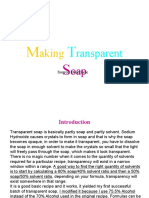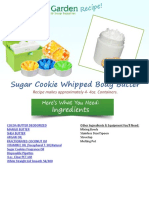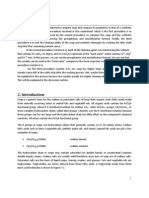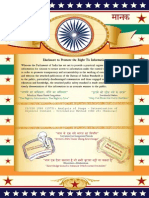Bar Shampoo
Uploaded by
Kathy Kemmis O'DriscollBar Shampoo
Uploaded by
Kathy Kemmis O'DriscollBar Shampoo
Recipe: 6.9oz. lye* 19oz. distilled water 3oz. avocado oil 4oz. wheat germ oil 9oz. castor oil 2oz. jojoba oil 16oz. coconut oil 14oz. vegetable shortening (or palm oil or beef tallow) 1oz. mango butter 2oz. cocoa butter You will need: 1. a digital scale. This is a absolutely the most important piece of equipment. You can buy them at Target or Wal Mart....but I bought mine on ebay from Old Will Knot....a good one is an escali brand and weighs up to at least 6 pounds or so. If you think you will want to sell soap or make bigger batches, get one that will weigh more. You will need the "tare function" and it must be able to measure in 1/10 oz.or.10 ounce increments. 2. A stick blender. I have had a seriously reliable Betty Crocker "SB" that I bought for $10 probably 10 years ago. I am sure any brand will be fine to start out or for occasional soap making. 3. A large stainless steel or non-pourice bowl or smooth pot. Enamel is fine as long as there are no chips. 3. A glass or Pyrex measurer with a pour spout (4 cup will do for small batches). This will be to measure and pour your lye solution into your oils. 4. A stainless steel or plastic spoon or spatula to stir the soap with. Either will do.
4. A small sturdy cup to measure your lye into and to pour dry lye into your glass container. I have found that metal containers cause static electricity at times and the beads "jump" and stick to the sides when you pour. Plastic will be fine. Some people use paper or plastic cups but I like to use something low and wide-mouthed. I have a weird plastic scoop....I think it actually goes to a thermos. Know what I mean? 5. A mold. Any "box" will do...or a loaf pan, Tupperware, etc. As long as it would fit about the same amount as a loaf pan because that is the size bacth you will do the first time. 6. Liner. I use and suggest freezer paper - the paper that is shiny on one side. It's where you find plastic wrap and it's usually on the bottom shelf. You can also use plastic trash can liners, but they aren't as easy to smooth (but they work fine). 7. Oils. Lets start with olive and coconut. These oils will make a wonderful bar of soap (some of you may not believe me but you must!). You can find them all at Wal Mart. Buy the cheapest olive oil they have (it is actually better for the soap because it has more saponifiables ). The coconut oil is found where you find all the oils....and it's right above the lard. Don't get the kind of coconut oil in the popcorn aisle - it will soap too (any oil will!) but it's a little different, more expensive, and it usually has beta carotene added. It will not hurt the soap but it will make it yellow . 8. Sodium Hydroxide (lye). I really have no idea where to buy it these days (I bought mine in drums from a chemical company until recently). I've heard that you can find it at Home Depot and at some drugstores or hardware stores. You used to be able to just go to the grocery and bye a 14 oz can of Red Devil - maybe you can in your state, but you can't in my town very easily (they take your idea and turn it in to the police because it is used in making meth ). Be sure it's sodium hydroxide (beads, pellets, flakes - it doesn't matter). If you can't find it, you can order it quite cheaply and in small amounts from soap supply companies like here: http://www.thesoapdish.com/caustics.htm
Once you have all of these things....you're on your way to making your very first batch of plain soap . I want you guys to make a simple, unscented batch to start because it's best to get the feel and the basic process down before adding fancies. Believe me....I'm saving you money and time by encouraging you to do it this way. I made several really bad mistakes before I finally made a stripped down recipe and the light bulb went off . Oh! If you have city water or water with a lot of lead you'll need distilled water. Safety Precautions: Lye is a caustic substance, which means it can cause burns to the skin. It is activated by moisture so even if you touch it dry, your skin has enough moisture in it to cause a lye burn. It will feel like you have been splattered with bacon grease. I have never had lye-water splashed or spilled on me so I don't know what it feels like...I'd assume it feels the same way but worse! I have however, felt raw lye and raw soap many times (ouch!). WEAR SAFETY GOGGLES OR GLASSES and rubber gloves as you make soap, from beginning to end. Wear long sleeves, pants and cover your feet. Hot soap, as you are pouring it is still active and WILL BURN YOUR SKIN if you touch it. DON'T touch it! I once got hot RAW soap on my gloved thumb, reached up to push my glasses up and stuck my thumb in my eye. I ended up going to the emergency room - no permanent damage but it scared the crap out of me and hurt like you can't believe! After your skin has been burned by hot soap it will sting much like a sunburn for a few minutes. IF you do come in to contact with lye or hot soap - RINSE WITH COOL RUNNING WATER. Do NOT use vinegar as people have suggested in years past (they thought it deactivated it, but it does not). Running water will sweep it away from the skin. Just as important: When lye and water combine there is a chemical
reaction that heats the solution up very fast. DO NOT BREATHE THE FUMES emitted from the lye water as it is heating up. This form can cause burns to your trachea and lungs if inhaled. Fortunately your body helps you immediatly by causing you to cough (reactively) before it gets to your lungs. But don't stick your head over the lye water to look at it - always stand off to the side a bit. Don't use a fan in the room while you are soaping as it will disperse the fumes and you will inadvertantly breathe them. The fumes will rise straight up otherwise and can be easily avoided. It doesn't last very long - maybe the first 4-5 minutes but it is mostly colorless so don't EVER check by sniffing or putting you head over - just assume at all times it is unsafe. Once the heating process halts, the fumes will not continue (again, assume they are there for safety's sake). There will be no active fumes if the lye-water is cooling or cooled but treat it with care because it will still burn if you touch it. *This is why I have you set your container into your sink basin in the instructions below - this way there is less risk of it being knocked over, and the container is lower and farther from your face. Lye + water +fat/protien makes soap. By mixing these things together in the proper ratio will change the chemical structure of all 3 ingredients and make SOAP (hence the comments you may read, there is no other way to make soap - if it doesn't have lye in it, it isn't soap). You must measure carefully (using a digital scale) because if you don't, you may have too much lye. Lye heavy soap contains lye that has not made partners with liquid and fat....and it's hanging out in it's pure form - and MAY STILL BE ACTIVE. If you make lye- heavy soap it can dry your skin horribly and possibly burn. This is where "lye soap" has gotten it's horrible reputation . Having said that - I make soap purposely a tad-bit heavy (+.025%) to use on poison ivy . *Never touch the lye. *Never touch the lye water or breath the fumes, or smell the mixture. *Never move the container that you have combined your lye and water in. Combine them in the sink basin where you can leave it to cool. *Never add water to lye (in that order). Only add the measured lye to the water, other wise you cause an inadvertant super heated solution at first and cause a volcanic eruption in the container.
*Never touch the raw soap while it is in liquid or soft stages (until you are experienced enough to recognize and predict when the soap is ready to be handled). *Never "fudge" a recipe - if you make a mistake, START OVER. Soap making is an exact science and until you are very experienced you can't risk making a soap that has improper ratios. *Never substitute one oil for another without running the recipe through a lye calculator first (I'll talk about that more at the bottom of this tutorial). ~~~~~~~~~~ The Process:
It is very, very important to set up a dry run before actually making soap. This may sound rudimentary, but it is important so that you know where everything will be sitting and if you have room for everything on your counter and sink. Believe me....this is really good advice so please don't ignore it (yep, I learned this the hard way too). Milk Soaps and soaps with special additives will be a little different. PLEASE take my advice and make at least 2-3 batches of a simple unscented recipe first. Then after you have a good feel of how things work, move on to adding just one additive; after that you will be ready to tackle blending scents and adding colorants and botanicals, etc. There are many different processes for making soap, and mine happens to be sort of a combination of several. This is MY method and routine...I would call it a mixture between CP and RT (Cold Process and Room Temerature soap making). But it's not just one process. It's the process I came up with after much trial and error. If you try this and find it's not your "thing" there are many other processes that may be more fun for you. But you will be successful at your first batch if you learn with this tutorial! Then you will be sucked into the Soap Makers Vortex and you will lay awake at night dreaming of oil combinations (fair warning!). ~~~~~~~
YOUR FIRST RECIPE: I have included 2 recipes actually; one vegan and one with lard. Yes, lard. Dove has lard in it, as does Lever 2000 and Caress...and all of them really (only it's called "sodium lardate"...it makes a nive hard, lathery bar and it's inexpensive). So don't panic unless you are vegan and never knew that. Then, the good news is you can make your own vegan soap now . This recipe is for a 40 ounce batch of soap. In soap making terms, that means that is the amount of oils used in the recipe. It does not include water or liquids used when identifying it this way. I am basing this on a 9x4 inch (cm:23x10x7deep) loaf pan. If you do not have one, you can use anything similar in size or shape. If you are using something totally different, post the size here and I'll resize the recipe.
Basic Unscented 40 ounces: Coconut Oil 6 (15%) Olive Oil 28 (70%) Lard 6 (15%) Lye 5.4 ounces Water 10 ounces or for those of you outside of the US ~ Basic Unscented 1130 grams: Coconut Oil 170 (15%) Olive Oil 790 (70%) Lard 170 (15%) Lye 152 grams Water 285 grams Basic Unscented Vegan: Coconut Oil 6 ounces(170g) Olive oil 34 ounces (964g) Lye 5.4 ounces (152g)
Water
10 ounces (285g)
Print these directions off and set them on the counter and do a "dry run" before you try it for real. To line your pan/mold, simply cut a piece of freezer paper about the same size that you would need to wrap it (like a gift). Then you will do a "reverse wrap", creasing it inward (shiny side to the soap) and tape along the outside edge. It's a PITA.... but will be important to know how to do if you move on to wooden molds later. This needs to be done before you start making soap. If you don't you'll have a serious problem! ***If you are using a glass or silicone (or tupperware/rubbermaid) mold, you will not need to line it. You only need to line a metal (wooden or cardboard) mold.***** And if it is a non stick pan, you probably won't have to line it either (never tried this though but I don't recommend it as you may need to slide a knife down the side of the soap to get it out and you'll mar the coating on your pan). If you are using a plastic liner (like a trash can liner) you simply smooth it along the inside (cut it down of course) and tape it to the outside. The corners will be funky but you can trim those ends of the soap off so it won't matter.
DIRECTIONS TO PRINT OFF, READ SEVERAL TIMES, AND DO A DRY-RUN WITH: 1. Preheat the oven at about 160-170 F48-60*C. 2. Set your water container on your scale and use the tare function; measure your water. A glass, heat proof Pyrex measure with a spout works very well I prefer glass but stainless or plastic are fine as well. Set the container in the sink basin.
3. Set a small container on your scale to measure the lye (use the tare again). Carefully pour the lye into the container on the scale. 4. Very carefully and slowly pour the measured lye into your measured water (while it's still setting in the sink). Handle the lye with extreme caution (do not spill it on the counter, or leave some in measuring containers). Use a non wooden spoon to stir the mixture gently, scraping the bottom to move granules about the water. Do not breathe the fumes during this process. Do not to stand with your face directly over the lye water as the fumes will rise straight up. Just stir a bit and step away. Its important to turn your faucet away so that by some accident someone doesnt turn the water on (or drips into the carefully weighed solution). Leave to cool. DO NOT TOUCH THIS MIXTURE FOR ANY REASON. 4A. (added to fit posted recipe). Gently warm Coconut oil and lard on low heat. Just heat until they are soft - not liquid. Set aside. 5. Measure your oil into your large soap pot that is on the scale (again, use the tare function). Measure carefully and slowly. Pour the olive oil first, hit tare on your scale, then add the cococonut and lard (scrape every last bit out, using a rubber spatula), hit tare again. Your scale should read 40 ounces. Set the soap pot with measured oils into the sink basin next to the lye water. 6.[This is where you WOULD measure essential oils and set aside...but not for your first recipe please!]. 7. When the lye water is BBW to the touch (that is my own termit means baby bottle warm) you are ready to make soap. You determine this by touching the outside of the container. DO NOT TOUCH THE MIXTURE. Be sure it would be the temperature to feed to a baby (if it wasn't a caustic solution ). Be sure to have the following ready:
Mold is ready, on the counter as close to sink as possible. Stick blender is ready, plugged in and the cord will not get into soap. Spatula is handy for scraping the soap into the mould [Essential oils or additives are measured and close to your soap pot]. Carefully pour the lye water into the measured oils (in your soap pot); immediately begin mixing with your stick blender being careful not to allow the blender to break the surface (you dont want to splatter you can stop the blender to mix from the top down and then turn it back on again). The oil will begin to saponify instantly blending thoroughly is imperative. Scrape the sides with the spatula just as you would with batter. 8. [When soap is at thin cake batter consistency, [add the essential oils or fragrance here - but not on your first recipe!] Blend well (on high). Try not to let soap get to a thick pancake batter consistency [but get the eos blended quickly]. This is called "trace". You pour the soap at trace, when the soap will leave a trailing from a spoon. 9. At trace, pour the soap into the mold, using the spatula to scrape the sides of the pot. 10. Put the molded soap into preheated oven; leave the oven on for about 2-3 hours then turn off heat. Leave soap in the oven for at least 12 hours total. Try not to peek.
11. Remove soap from mold and slice with a smooth knife; arrange on wire racks and allow to cure in a dry, dark place (like a closet).
You will know when the soap is cured completely when you do a tongue test - if you touch your tongue to the soap and you feel a zap the soap is NOT ready to be used. If it simply tastes like salt.its ready!
This recipe has what is known as a "water discount". It will cure much more quickly than other recipes you will find on the net that use a higher % of water. Curing soap is traditionally done for about 4-8 weeks, but you only need to do this to allow the bar to harden so it will last longer. This soap can be used within a day or so, but will be best if allowed to cure for at least week. If you intend on making labels for it, allow another week so that you don't end up with loose wrappers because the bar will shrink slightly.
You might also like
- How To Make Transparent Soap - Curious Soapmaker100% (1)How To Make Transparent Soap - Curious Soapmaker14 pages
- Soap Making - 365 Days of Soap Making - 365 Soap Making Recipes For 365 Days (Soap Making, Soap Making Books, Soap Making For Beginners, Soap Making Guide, ... Making, Soap Making Supplies, Crafting)100% (7)Soap Making - 365 Days of Soap Making - 365 Soap Making Recipes For 365 Days (Soap Making, Soap Making Books, Soap Making For Beginners, Soap Making Guide, ... Making, Soap Making Supplies, Crafting)1,182 pages
- How To Make Soap: (One Thing About Soap Making You Will Learn.... There Are Always So Many Choices To Make!)No ratings yetHow To Make Soap: (One Thing About Soap Making You Will Learn.... There Are Always So Many Choices To Make!)50 pages
- Essential-Oil-Blends-For-Men - PDF Version 1 PDF100% (4)Essential-Oil-Blends-For-Men - PDF Version 1 PDF8 pages
- Basic Cold Process Soap Making Guide: by Amanda AaronNo ratings yetBasic Cold Process Soap Making Guide: by Amanda Aaron26 pages
- Smart Lotionmaking: The Simple Guide to Making Luxurious Lotions, or How to Make Lotion That's Better Than You Buy and Costs You Less: Smart Soap Making, #3From EverandSmart Lotionmaking: The Simple Guide to Making Luxurious Lotions, or How to Make Lotion That's Better Than You Buy and Costs You Less: Smart Soap Making, #3No ratings yet
- Cool Soapmaking: The Smart Guide to Low-Temp Tricks for Making Soap, or How to Handle Fussy Ingredients Like Milk, Citrus, Cucumber, Pine Tar, Beer, and Wine: Smart Soap Making, #5From EverandCool Soapmaking: The Smart Guide to Low-Temp Tricks for Making Soap, or How to Handle Fussy Ingredients Like Milk, Citrus, Cucumber, Pine Tar, Beer, and Wine: Smart Soap Making, #55/5 (1)
- Smart Soapmaking: The Simple Guide to Making Soap Quickly, Safely, and Reliably, or How to Make Soap That's Perfect for You, Your Family, or Friends: Smart Soap Making, #1From EverandSmart Soapmaking: The Simple Guide to Making Soap Quickly, Safely, and Reliably, or How to Make Soap That's Perfect for You, Your Family, or Friends: Smart Soap Making, #15/5 (1)
- Coconut Oil Shampoo Bar Recipe (Video Tutorial) PDF100% (1)Coconut Oil Shampoo Bar Recipe (Video Tutorial) PDF249 pages
- Bath and Body Recipes Collected From Various Places100% (4)Bath and Body Recipes Collected From Various Places16 pages
- How To Prevent Contamination in Cosmetic ProductsNo ratings yetHow To Prevent Contamination in Cosmetic Products25 pages
- Sugar Cookie Whipped Body Butter: Recipe Makes Approximately 4-4oz. ContainersNo ratings yetSugar Cookie Whipped Body Butter: Recipe Makes Approximately 4-4oz. Containers2 pages
- Guide To Soap Making Melt&Pour (MP Process)No ratings yetGuide To Soap Making Melt&Pour (MP Process)3 pages
- DIY Shea Butter Bath Bombs - WorldLifestyleNo ratings yetDIY Shea Butter Bath Bombs - WorldLifestyle3 pages
- Simple Organic Homemade Sunscreen Recipe Book Easy Sunscreen Recipes That Will Keep Your Skin Healthy Glowing (Stephanie Sharp) (Z-Library)100% (1)Simple Organic Homemade Sunscreen Recipe Book Easy Sunscreen Recipes That Will Keep Your Skin Healthy Glowing (Stephanie Sharp) (Z-Library)68 pages
- Essential Oils For Soapmaking Chart UpdatedNo ratings yetEssential Oils For Soapmaking Chart Updated3 pages
- DIY Organic Skincare Recipes: Bumblebee Apothecary PresentsNo ratings yetDIY Organic Skincare Recipes: Bumblebee Apothecary Presents6 pages
- Preparation of Soaps by Using Different Oil and Analyze Their PropertiesNo ratings yetPreparation of Soaps by Using Different Oil and Analyze Their Properties5 pages
- My Buttered Life Personal Care Edition Final100% (4)My Buttered Life Personal Care Edition Final18 pages
- Soap Making - Kelly Kohn (CreateSpace, 2012)100% (1)Soap Making - Kelly Kohn (CreateSpace, 2012)108 pages
- Instant ebooks textbook (Ebook) Network Security Assessment Know Your Network by Chris McNab ISBN 9781491910955, 149191095X download all chapters100% (11)Instant ebooks textbook (Ebook) Network Security Assessment Know Your Network by Chris McNab ISBN 9781491910955, 149191095X download all chapters65 pages
- Oil, Soap and Detergents IndustryIM-masitaNo ratings yetOil, Soap and Detergents IndustryIM-masita107 pages
- PDF Web Api Interview Questions - CompressNo ratings yetPDF Web Api Interview Questions - Compress32 pages
- Introduction To Computers Lab Manual 3: University of Engineering and Technology, TaxilaNo ratings yetIntroduction To Computers Lab Manual 3: University of Engineering and Technology, Taxila25 pages
- Download Essentials of Microservices Architecture Paradigms Applications and Techniques 1st Edition Chellammal Surianarayanan (Author) ebook All Chapters PDF100% (4)Download Essentials of Microservices Architecture Paradigms Applications and Techniques 1st Edition Chellammal Surianarayanan (Author) ebook All Chapters PDF55 pages
- Water Proof and Water Repellant FinishesNo ratings yetWater Proof and Water Repellant Finishes10 pages
- SecureSpan SOA Gateway Gateway & Software AGNo ratings yetSecureSpan SOA Gateway Gateway & Software AG4 pages

























































































